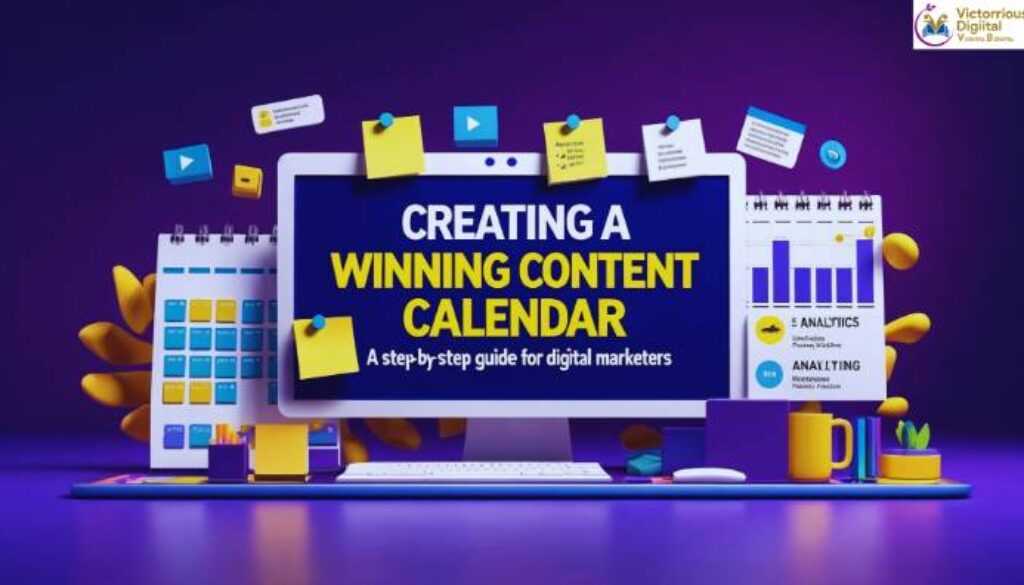Creating a Winning Content Calendar
Table of Contents
Creating a Winning Content Calendar: A Step-by-Step Guide for Digital Marketers
In digital marketing, content is king. But just creating content is not enough—you need to plan it smartly. A well-organized content calendar helps businesses stay consistent, focused, and ahead of their competitors. Whether you are a digital marketer, a business owner, or a student learning through a Digital Marketing course, understanding how to create a content calendar is a must.
This blog will explain what a content calendar is, why it is important, and how you can create one easily. We will also share tips used by professionals and institutes that train students to become job-ready content marketers.
What is a Content Calendar?
A content calendar (also called an editorial calendar) is a simple tool that helps you plan and schedule your content. It can be a spreadsheet, a calendar app, or even a printed planner that shows what content you are going to post, when, and on which platform.
For example, if you are managing a brand’s Instagram, website blog, and YouTube channel, a content calendar will help you decide:
- What to post each day
- Which topic to cover
- Which platform to post it on
- Who will create the content
- When to publish it
It brings structure to your content marketing efforts and helps you stay consistent.
Why is a Content Calendar Important?
1. Keeps You Organized: A content calendar gives you a bird’s-eye view of your content plan. Instead of thinking last-minute “What should I post today?”, you already have a plan. This helps save time and reduces stress.
2. Maintains Consistency: Posting content regularly is important for audience engagement and SEO. Whether it’s blogs, social media posts, or videos, a content calendar ensures that you never miss a post.
For example, Victorious Digital, a top Digital Marketing Training Institute in Pune, follows a weekly content calendar for their blogs and Instagram posts to attract students regularly.
3. Helps in Planning Campaigns: When festivals, product launches, or special events come up, you can plan themed content in advance. This helps your brand stay relevant and timely.
4. Avoids Repetition: Sometimes marketers unknowingly post similar content again and again. A calendar helps track what has already been posted and encourages new ideas.
5. Improves Team Collaboration: If you’re working with a team—writers, designers, or social media managers—a shared content calendar keeps everyone on the same page. Everyone knows what’s coming and what needs to be done.
Steps to Create a Winning Content Calendar
Step 1: Define Your Goals
Before you start, ask yourself:
- What do you want to achieve with your content?
- Is it more website traffic? More leads? Brand awareness?
For example, if Victorious Digital wants to increase admissions to their digital marketing courses, their goal would be to create content that explains course benefits, success stories, and career outcomes.
Step 2: Know Your Audience
Understand who you are creating content for. What are their interests, age group, problems, or goals?
If you are targeting students who are looking for “Digital Marketing courses in Pune with placement,” your content should include:
- Course details
- Placement records
- Student reviews
- Career tips
Step 3: Choose the Right Platforms
Decide where you will post your content:
- Blog
- YouTube
- Email newsletter
Each platform has a different audience. For example:
- Instagram is good for short, visual content
- YouTube is great for tutorials
- Blogs help improve your SEO
Victorious Digital uses a mix of these platforms to connect with students at different stages of their learning journey.
Step 4: Pick Content Types
Now decide what kind of content you’ll post:
- Blog posts
- How-to videos
- Student testimonials
- Instagram reels
- Infographics
- Success stories
- Live Q&A sessions
A mix of different formats keeps the audience engaged.
Step 5: Plan Your Content Themes
You can break your month into weekly themes. For example:
WeekTheme
- Week 1 Course Highlights
- Week 2 SEO Tips
- Week 3 Career Guidance
- Week 4 Student Reviews
This way, your content remains focused but still has variety.
Step 6: Use a Simple Tool to Build the Calendar
You don’t need fancy tools. Start with a simple Google Sheet or Excel file. You can also use tools like:
- Trello
- Notion
- Google Calendar
- Asana
- ContentStudio
Make sure to assign tasks to the right person and track progress.
Step 7: Stay Flexible
A content calendar should guide you—not control you. If something trending happens or you get a new idea, you can always adjust your plan.
For instance, if there’s a new Google algorithm update, Victorious Digital quickly writes a blog post about it—even if it wasn’t originally planned—because it’s relevant to their audience.
Tips to Keep Your Content Calendar Effective
1. Plan at least one month in advance – Block 2-3 days at the end of each month to plan for the next one.
2. Use real data to improve – Track which posts get the most views, clicks, or shares. Use this data to decide what type of content to make more of.
3. Repurpose content – Turn one blog into a video. Turn one video into multiple Instagram posts. This saves time and keeps your message consistent.
4. Add important dates – Mark special days like:
- Course launch dates
- Student admission deadlines
- Industry events
- Festivals
5. Include call-to-action (CTA): Every post should guide the audience:
- “Join our course now”
- “Download the free guide”
- “Watch the full video on YouTube”
Example: Victorious Digital’s Weekly Content Calendar Plan
Let’s look at how Victorious Digital might use a content calendar:
- Monday – Blog: “Top 5 Digital Marketing Job Roles in 2025”
- Tuesday – Instagram Reel: Quick SEO Tip
- Wednesday – Student Testimonial Video
- Thursday – LinkedIn Post: Industry news + opinion
- Friday – YouTube Video: “What to Expect in a Digital Marketing Course”
- Saturday – Instagram Story Q&A with Trainers
- Sunday – Day off or casual content like motivational quotes or fun facts
This balanced content schedule helps them educate, engage, and attract students.
Conclusion
A content calendar is a simple but powerful tool that helps you stay organized, consistent, and strategic in your digital marketing journey. Whether you are running a business, managing a brand’s social media, or studying at a Digital Marketing institute in Pune, using a content calendar will save time and improve results.
Learning how to plan and execute a content strategy is part of most Digital Marketing courses in Pune, including those offered by Victorious Digital. Their expert-led training, practical projects, and placement support prepare students to handle real-world content marketing challenges with confidence.
So, if you’re looking to master skills like SEO, content planning, social media, and more—joining a hands-on digital marketing course can be your first step toward a successful marketing career.
Read Also: How to Climb the Career Ladder in Digital Marketing?




